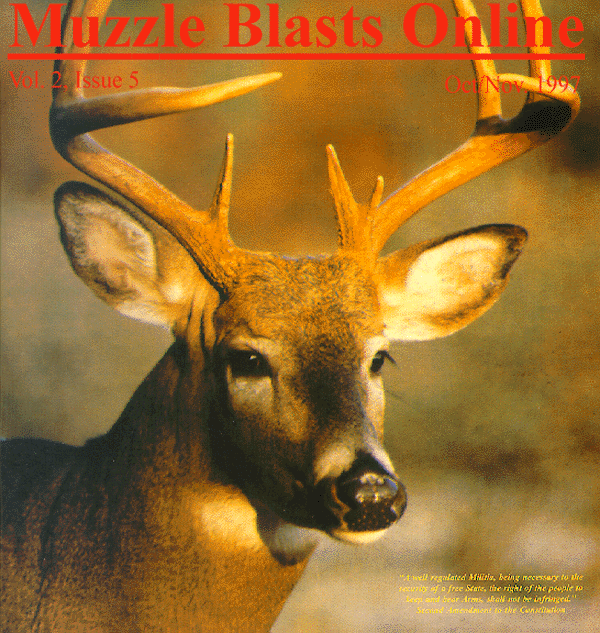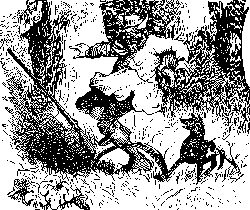|
Muzzle Blasts Online |
|
...for the muzzleloading enthusiast |
|
The muzzleblasts.com domain, subdomains, content, etc., are neither affiliated with the NMLRA nor its paper magazine Muzzle Blasts |
|
Muzzle Blasts Online |

|
|
|
|
|
|
Safe Gun Handling In The Field

|
"SHHHKOW"! A shot from a flintlock got our sudden, undivided attention.
One glance toward the shooter was enough to know the shot had been an unintentional discharge. There was no need to chastise the shooter. His hang-dog expression and the bright scarlet color of his face were ample evidence that he was fully aware of his error. "I thought it was only on half-cock." he explained later. "I guess I was wrong." Fortunately, the muzzle of his 12 gauge Brown Bess musket had been pointed at the ground beside the trail, and not at someone's body.
Although hunting and historic trekking are among the safest of outdoor sports, any time we handle firearms, safety must be uppermost on our minds. Even a microsecond of carelessness can spell disaster. There are only 2 causes of unintentional gunshots--mechanical malfunction of the firearm, and shooter error.
In order to be safe in the woods, your gun must be in good mechanical condition. Before leaving on a trek or hunt inspect the firearm carefully. The hammer or cock should be held securely in both the half-cock and full-cock positions. From half-cock, it should be impossible to drop the hammer by pulling the trigger. To test the lock in the full-cock position, press the hammer or cock firmly forward with your thumb. It should be impossible to dislodge the hammer unless the trigger is pulled.
Hangfires can result in the shot firing in an uncontrolled direction, perhaps missing the target or backstop completely. Ignition problems are frustrating and stressful, and may be so upsetting as to affect the shooter's judgment. Keep your lock properly tuned, and replace worn flints or nipples early to keep ignition problems to a minimum. When you do have a misfire, keep the gun pointed down range, and wait at least one full minute before repriming.
A broken sling can result in the gun dropping, perhaps dislodging the hammer and allowing it to fire unintentionally. If your gun is equipped with a sling, inspect it regularly for wear and cracks. Frequent applications of tallow, lard, or commercial leather dressing can extend a leather sling's useful life considerably, and reduce the risk of accidents. The time to replace a worn sling is the first time you find yourself thinking about it. Inspect it before each outing.
When carrying a loaded muzzleloader with a sling, it's generally safest to sling it so the barrel is pointed upward, rather than toward the ground. If pointed downward, the ball or shot column could become dislodged and migrate away from the powder charge as you are walking or moving about. If you try to fire the gun, the dislodged projectile will act like an obstruction in the barrel, perhaps causing it to burst. Even when carried barrel up, the wise shooter regularly uses the ramrod to ensure the ball is completely seated on the powder charge. Be sure you decap or deprime first, though.
Hunters usually carry their guns loaded, but trekkers may decide an empty rifle is safer on the trail, especially when traveling in a large party. As a general rule of thumb, decide why you want to load the gun before pouring powder or ramming lead. Hunting, protection from dangerous animals, and perhaps even protection from hostile people are all valid reasons for carrying a loaded gun. If none of these apply to your trek, it's probably safer to leave the gun empty.
Just because the gun is loaded doesn't mean you need to prime or cap it. Many big game hunters wait until they are actually stalking game before priming their muzzleloaders, and that's a reasonable precaution for trekkers as well. At least in theory, it should be impossible for an unprimed muzzleloader to fire. (Editors' Note: But don't rely on it!)
If for some reason you decide to carry your muzzleloader "hot" (both loaded and primed), as the Bad Company Brigade shooter in the introduction was doing, be certain the hammer is at half-cock, and don't touch the trigger for ANY reason except to shoot the gun. If you want to check the hammer's position, carefully lower the hammer then pull it back into position. If you don't shoot the primed firearm, remove the cap or knock out the priming powder as soon as know you won't be firing.
Flintlock shooters can also use a safety device called a "hammer stall" to help prevent unintentional discharges. A hammer stall is a leather cover that fits over the frizzen, like a stocking fits over your foot. If the hammer should fall, the hammer stall prevents the flint from striking a spark and discharging the firearm. When you're ready to shoot, the hammer stall can be removed quickly and silently. Though not a replacement for good judgment and safe gun handling habits, the use of a hammer stall can help prevent accidents. Many reenactment and skirmish associations require hammer stalls on all flintlock guns at their event.
One of the most important rules of gun handling in the field is pay attention to that muzzle. Never point a gun, even one you know is unprimed and empty, at anything you don't intend to shoot. The only reason nobody was injured during the unintentional discharge described early in this article was that the shooter had developed the unconscious safety habit of always keeping his gun pointed in a safe direction.
Fences, creeks, and other obstructions in the trail should be crossed cautiously. If your gun is hot remove the priming powder or cap. When conditions allow, hand your gun to a companion while you cross the obstruction. Once on the other side he can then hand you both guns to hold while he crosses. Mud, ice, or snow all make for very slippery trail conditions. If you aren't sure of your footing, it's safest to carry the gun empty. Unprimed is second best.
Although loaded guns are prohibited in most rendezvous camps, the same rule doesn't necessarily apply on a historic trek or hunt--especially in grizzly bear country. Loaded guns can usually be safely kept in a hunting or trekking camp, as long as they aren't primed or capped. Many flintlock shooters place a quill or feather in the touch hole to prevent moisture from contaminating the powder charge, and to signal that the gun is loaded but unprimed. (This also keeps the small grains of powder from sifting through the touch-hole and priming the pan.) Loaded percussion guns can be kept at half-cock, so everyone can see there is no cap on the nipple.
When taking a break or setting up camp, be careful about storing your muzzleloader. It's usually safer to lay it across your bedroll or on the ground than to lean it against a tree. If you do decide to lean your gun against a tree or other surface, be certain that a sudden breeze, clumsy critter, or another camper won't knock it over.
The most important rule of firearm safety is to use common sense at all times. This rule is sometimes more difficult to follow than you might think. A wide variety of physical and emotional conditions can impair your judgment, making it difficult to recognize and/or correct safety hazards. Physical stressors include fatigue, hunger, thirst, temperature extremes, and illness. Emotional stressors include fear, anger, anxiety, boredom, and frustration. All these stress-producing conditions are routinely encountered during hunts and historic treks. Anytime you feel less than your very best, you should be especially cautious with firearms--avoid handling them altogether when angry or frustrated.
Alcohol or drug use, even in moderation, can destroy a shooter's judgment. The vast majority of both intentional and accidental shootings in the United States are associated with the use of drugs and alcohol. Don't forget that many legal prescription and nonprescription drugs can also impair your judgment. If the drug's label includes a warning about operating motor vehicles or dangerous equipment, remember that muzzleloading firearms definitely qualify as dangerous equipment.
Everyone in your hunting or trekking party is responsible for safe gun handling. Keep an eye on your companions, and if you see something that doesn't seem 100% safe, bring it to the shooter's attention. Although old timers in the shooting and living history sports are generally expected to teach newcomers safe procedures, even experienced shooters can suffer moments of "brain lag." No one should ever be upset when someone corrects a safety problem or challenges a questionable gun handling procedure.
To hunters and historic trekkers, a firearm is more than just a historically authentic prop. Like our frontier ancestors, we carry our muzzleloaders to hunt food, and to provide a degree of security from dangerous animals. Anytime we carry or handle a firearm, safety MUST be our highest priority. The only difference between an unintentional discharge and a fatality may be the direction in which the muzzle is pointed. Let's not leave that to chance.